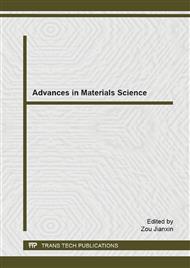[1]
R. Sram, M. Dostal, H. Libalova, P. Rossner, A. Rossnerova, V. Svecova, J. Topinka, A. Bartonova, The European Hot Spot of B[a]P and PM2. 5 Exposure—The Ostrava Region, Czech Republic: Health Research Results. Hindawi Publishing Corporation. 2013 (2013).
DOI: 10.1155/2013/416701
Google Scholar
[2]
Directive 2004/107/EC of the European Parliament and of the Council of 15 December 2004 relating to arsenic, cadmium, mercury, nickel and polycyclic aromatic hydrocarbons in ambient air. Official Journal of the European Union, (26. 1. 2005).
Google Scholar
[3]
Information on http: / http: /portal. chmi. cz/files/portal/docs/uoco/isko/tab_roc/tab_roc_CZ. html.
Google Scholar
[4]
A. Šišović, I. Bešlić, K. Šega, V. Vadjić, PAH mass concentrations measured in PM10 particle fraction. Environment International. 34 (5) (2008) 580-584.
DOI: 10.1016/j.envint.2007.12.022
Google Scholar
[5]
C.A. Belis, J. Cancelinha, M. Duane, V. Forcina, V. Pedroni, R. Passarella, G. Tanet, K. Douglas, A. Piazzalunga, E. Bolzacchini, G. Sangiorgi, M. -G. Perrone, L. Ferrero, P. Fermo, B.R. Larsen, Sources for PM air pollution in the Po Plain, Italy: I. Critical comparison of methods for estimating biomass burning contributions to benzo(a)pyrene. Atmospheric Environment. 45 (39) (2011).
DOI: 10.1016/j.atmosenv.2011.08.061
Google Scholar
[6]
D. Treissman, J. Vidmar, S. Guigard, W. Kindzierski, J. Schulz, E. Guigard, Review Of Approaches For Setting An Objective For Mixtures In Ambient Air Using Polycyclic Aromatic Hydrocarbons (PAHs) As An Example: Benzo[A]Pyrene. (2004).
Google Scholar
[7]
G. Jin, L. Cong, Y. Fang, J. Li, M. He, D. Li, Polycyclic aromatic hydrocarbons in air particulates and its effect on the Tumen river area, Northeast China. Atmospheric Environment. 60 (2012) 298-304.
DOI: 10.1016/j.atmosenv.2012.06.074
Google Scholar
[8]
M. Dostal, A. Pastorkova, S. Rychlik, E. Rychlikova, V. Svecova, E. Schallerova, R. J Sram, Comparison of child morbidity in regions of Ostrava, Czech Republic, with different degrees of pollution: a retrospective cohort study. Environmental Health. (2013).
DOI: 10.1186/1476-069x-12-74
Google Scholar
[9]
Y. Da Limu, D.T. LiFu, A.Y. Miti, X. Wang, X. Ding, Autumn and wintertime polycyclic aromatic hydrocarbons in PM2. 5 and PM2. 5–10 from Urumqi, China. Aerosol and Air Quality Research. 13 (2013) 407–414.
DOI: 10.4209/aaqr.2012.05.0130
Google Scholar
[10]
I. Jakovljević, G. Pehnec, V. Vađić, Pah's concentrations in PM10, PM2. 5 and PM1 particulate fraction in the air. 19th International Symposium on Separation Sciences New Achievements in Chromatography / Šime Ukić and Tomislav Bolanča (ed). – Zagreb. Poreč, Hrvatska, (2013).
Google Scholar
[11]
J. Matschullat, R, Ottenstein, C. Reimann. Geochemical background - can we calculate it?. Environmental Geology. 39 (9) (2000) 990-1000.
DOI: 10.1007/s002549900084
Google Scholar
[12]
Z. Nakić, K. Posavec, A. Bačani, A Visual Basic Spreadsheet Macro for Geochemical Background Analysis. Ground Water. 45(5) (2007) 642-647.
DOI: 10.1111/j.1745-6584.2007.00325.x
Google Scholar
[13]
M.S. Callén, M.T. De la Cruz, J.M. López, A.M. Mastral, PAH in airborne particulate matter.: Carcinogenic character of PM10 samples and assessment of the energy generation impact. Fuel Processing Technology. 92 (2) (2011) 176-182.
DOI: 10.1016/j.fuproc.2010.05.019
Google Scholar
[14]
M. Mandalakis, M. Tsapakis, A. Tsoga, E.G. Stephanou, Gas-particle concentrations and distribution of aliphatic hydrocarbons, PAHs, PCBs and PCDD/Fs in the atmosphere of Athens (Greece). Atmospheric Environment. 36 (2002) 4023–4035.
DOI: 10.1016/s1352-2310(02)00362-x
Google Scholar
[15]
E. Galarneau, Source specificity and atmospheric processing of airborne PAHs: Implications for source apportionment. Atmospheric Environment. 42 (2008) 8139–8149.
DOI: 10.1016/j.atmosenv.2008.07.025
Google Scholar
[16]
A. A. Jamhari, M. Sahani, M.T. Latif, K.M. Chan, H.S. Tan, M.F. Khan, M. Tahir, Concentration and source identification of polycyclic aromatic hydrocarbons (PAHs) in PM10 of urban, industrial and semi-urban areas in Malaysia. Atmospheric Environment 86 (2014).
DOI: 10.1016/j.atmosenv.2013.12.019
Google Scholar
[17]
E.C. Teixeira, D.M. Agudelo-Castañeda, J.M. Guimarães Fachel, K.A. Leal, G. Oliveira Garcia, F. Wiegand, Source identification and seasonal variation of polycyclic aromatic hydrocarbons associated with atmospheric fine and coarse particles in the Metropolitan Area of Porto Alegre, RS, Brazil. Atmospheric Research. 118 (15) (2012).
DOI: 10.1016/j.atmosres.2012.07.004
Google Scholar


